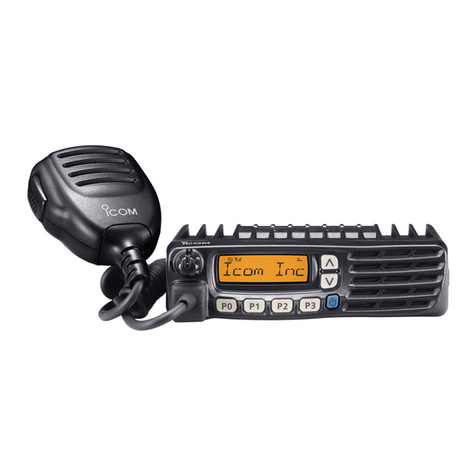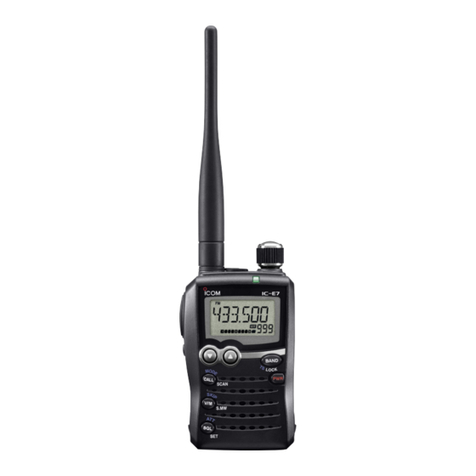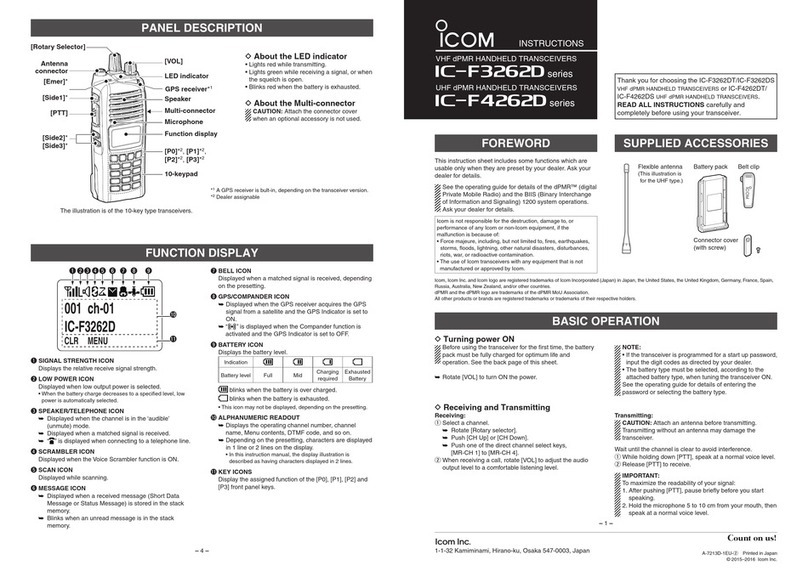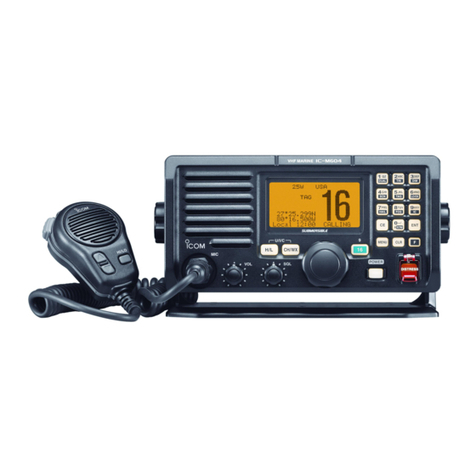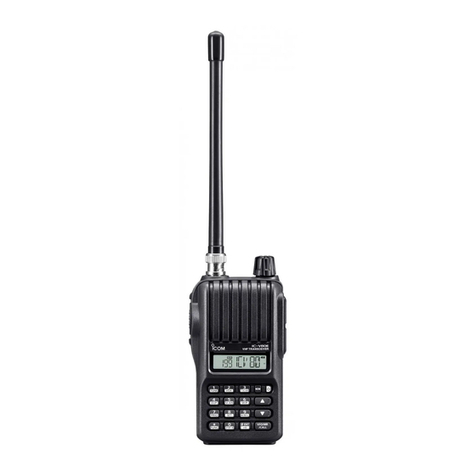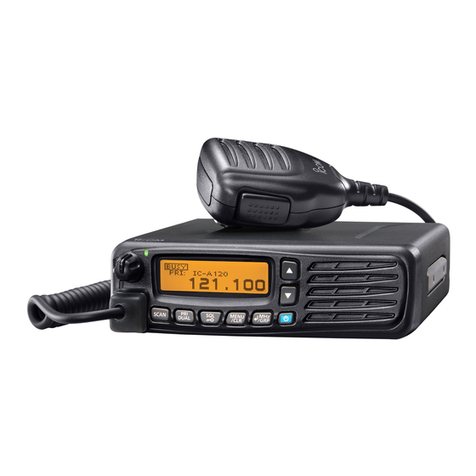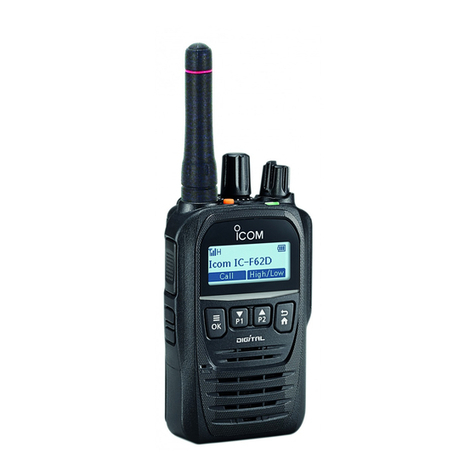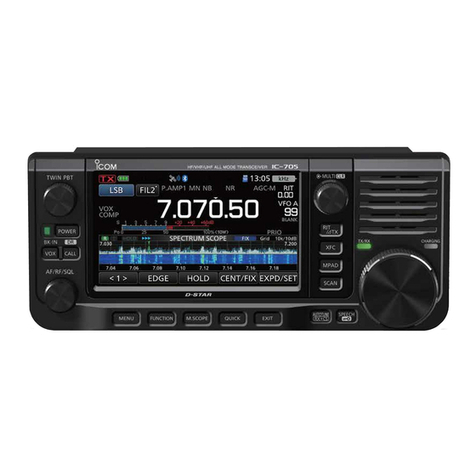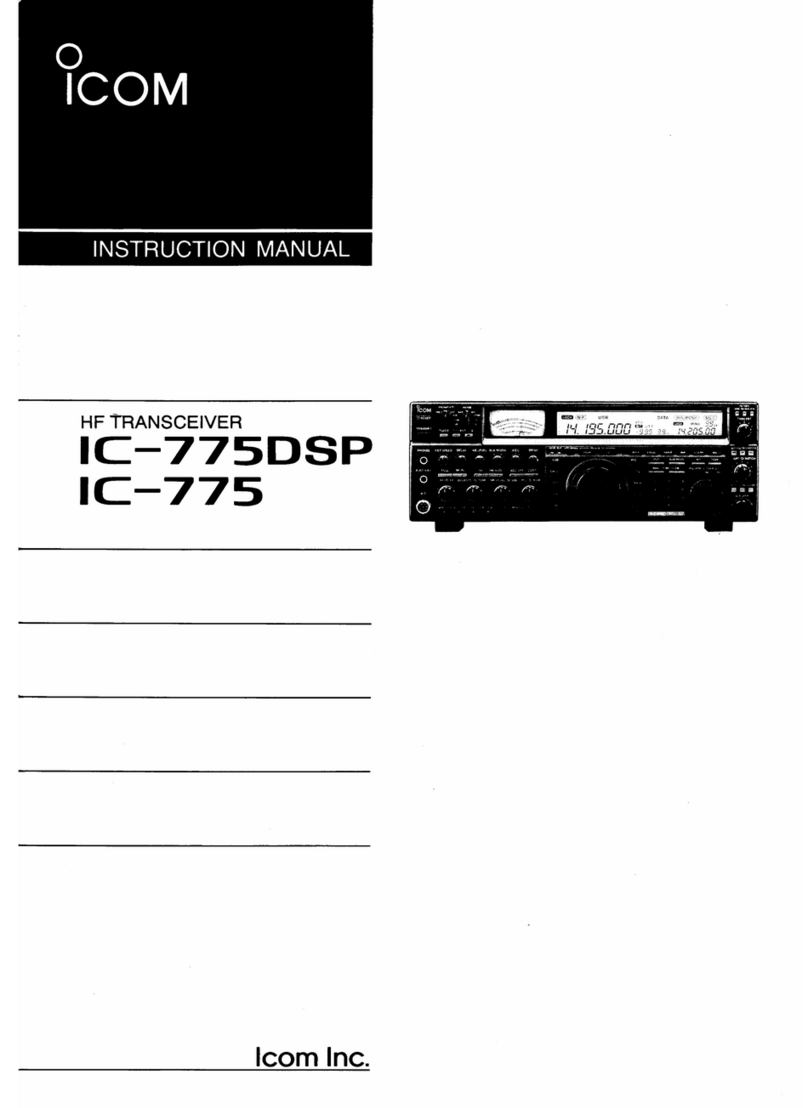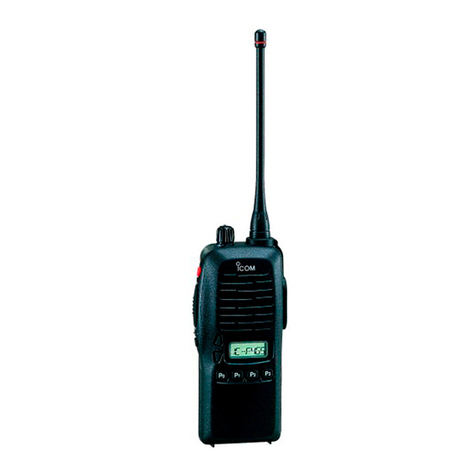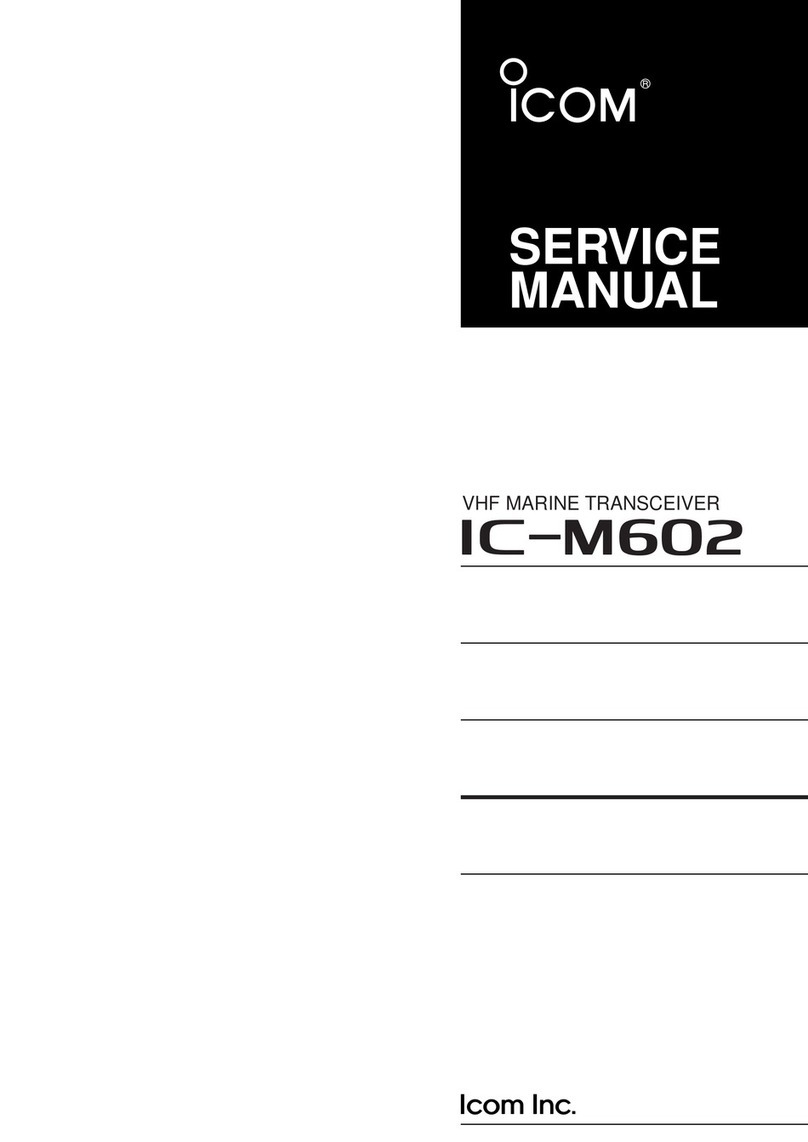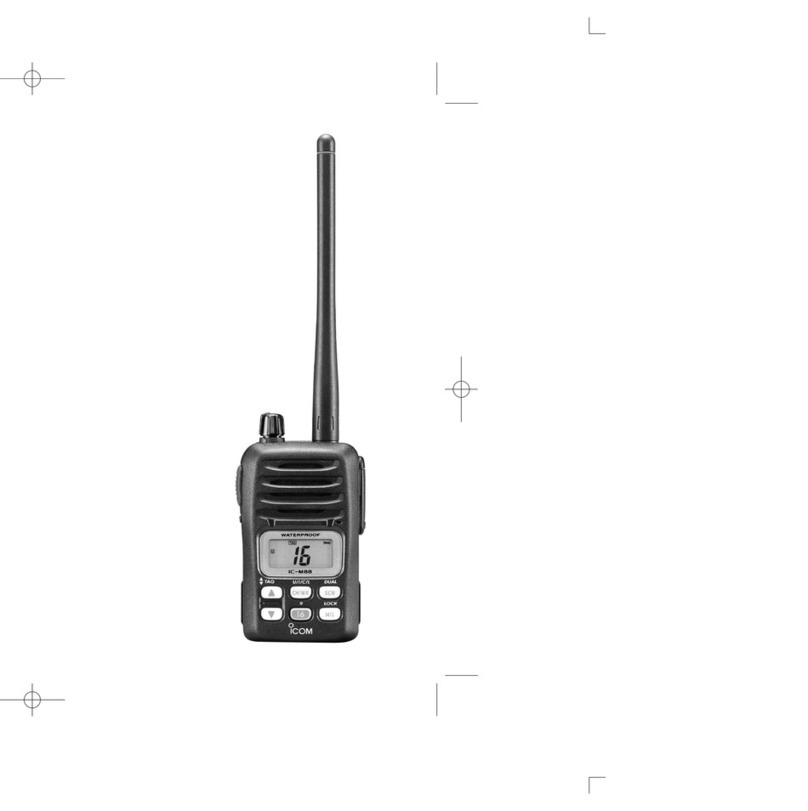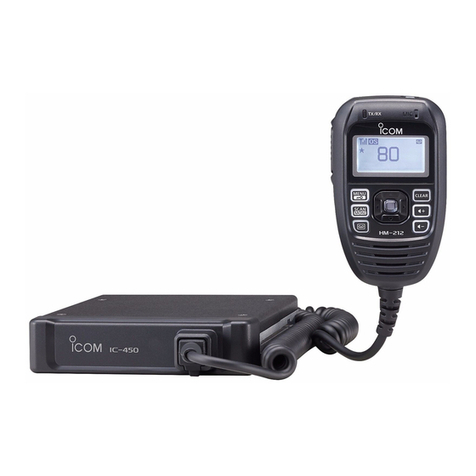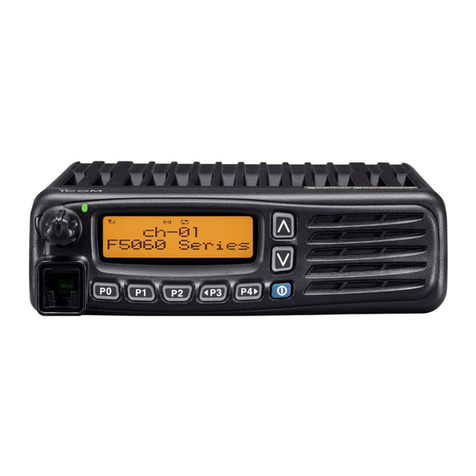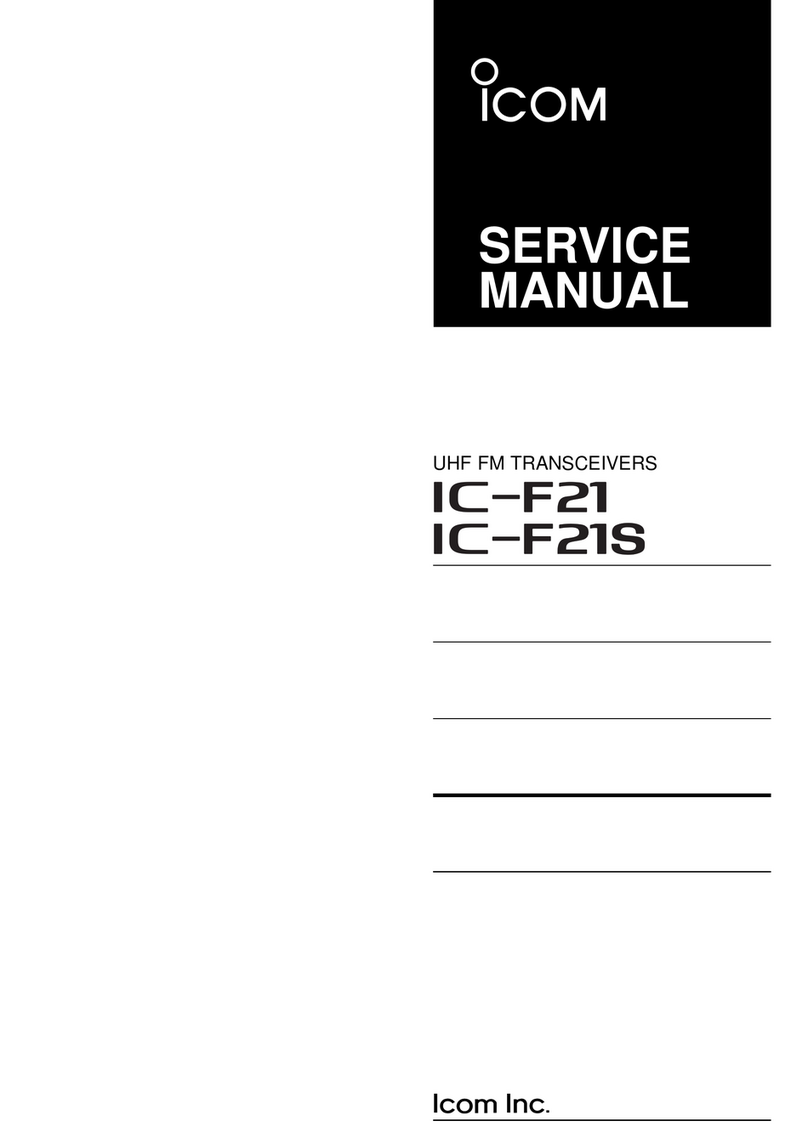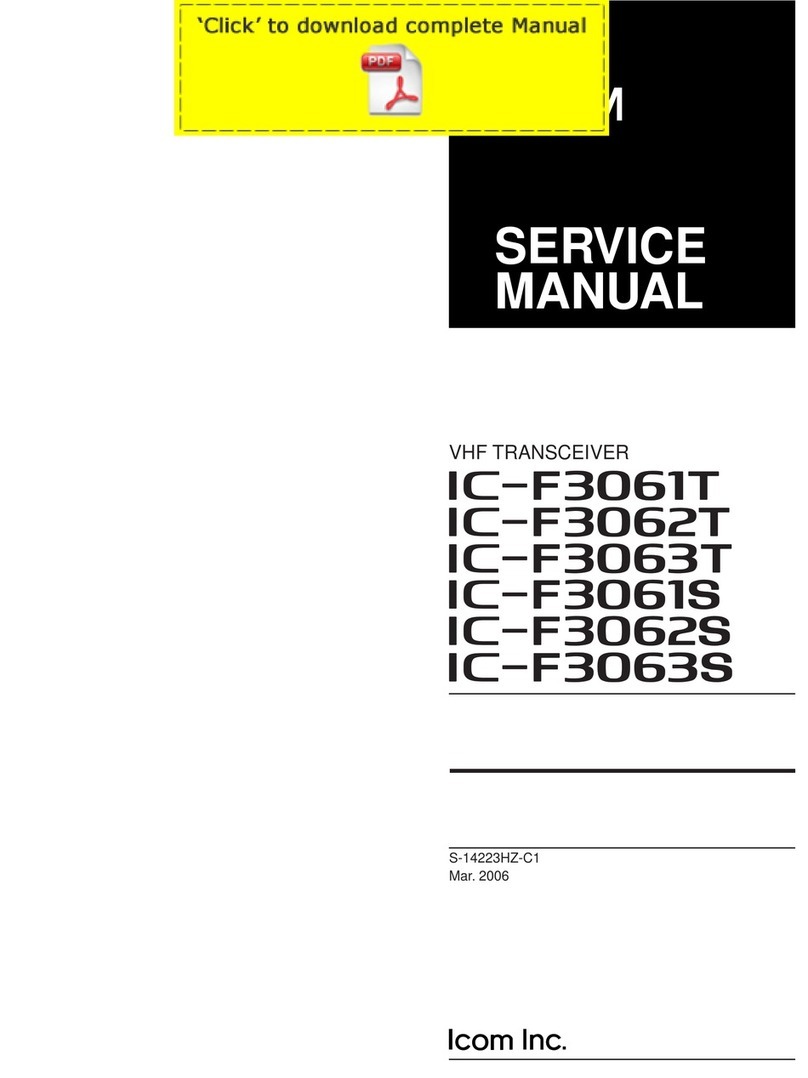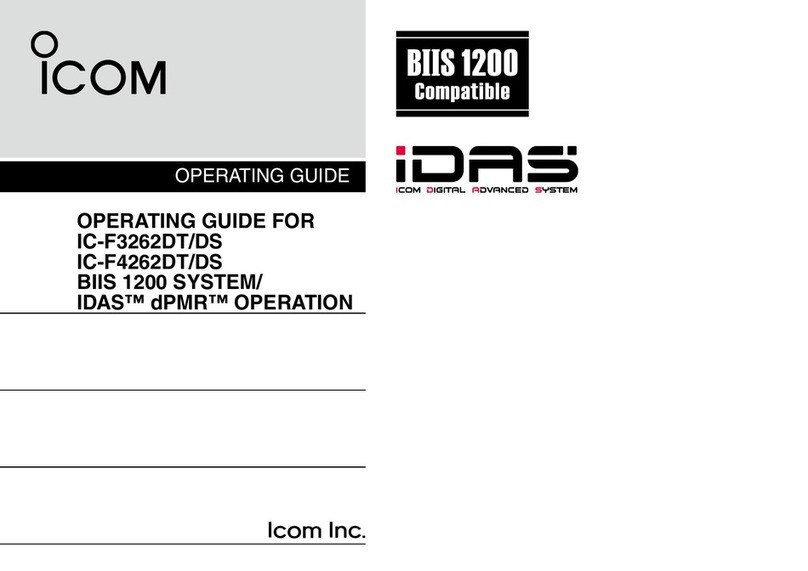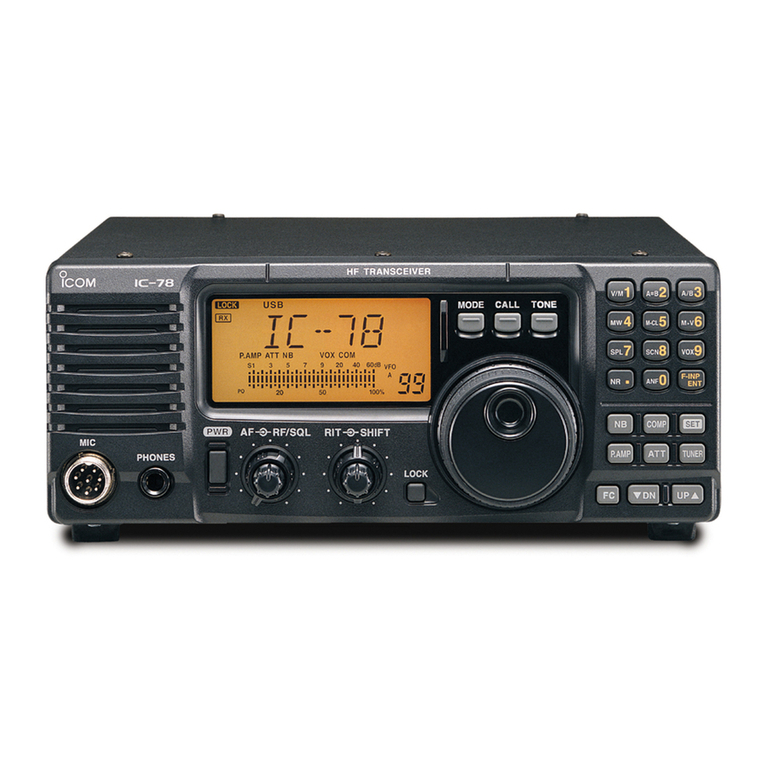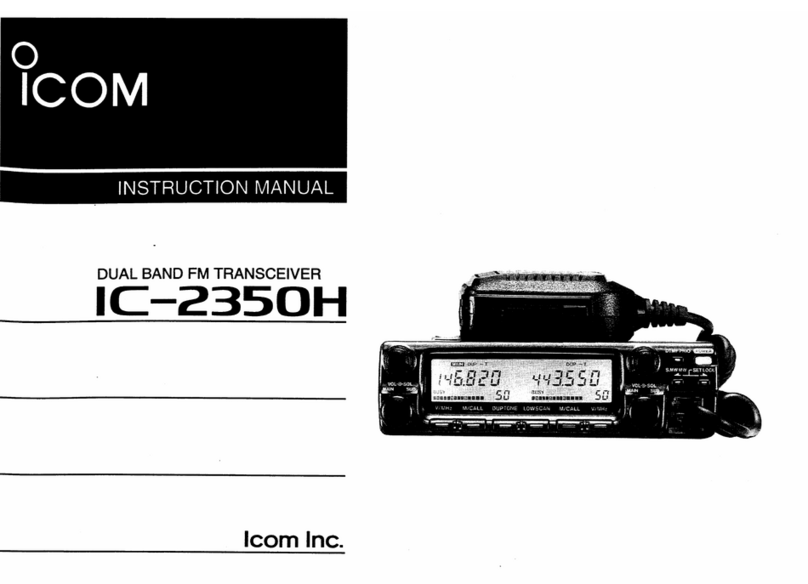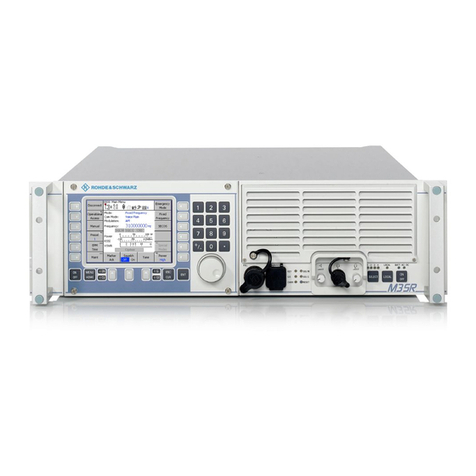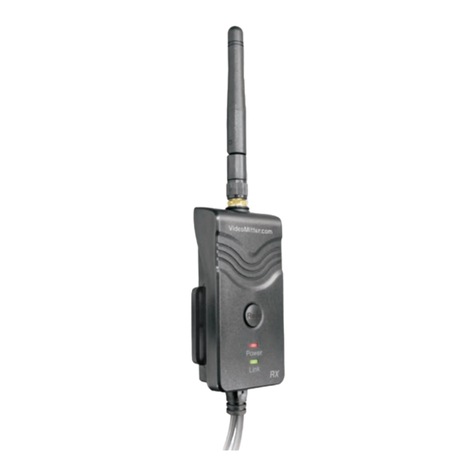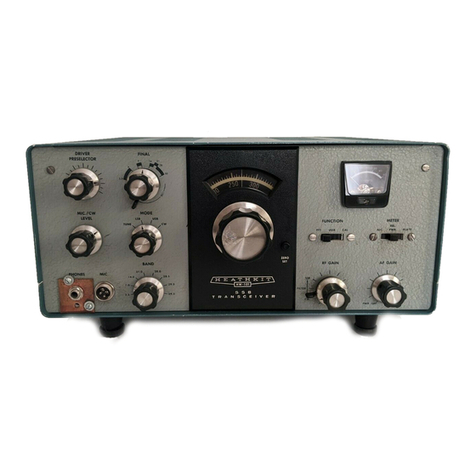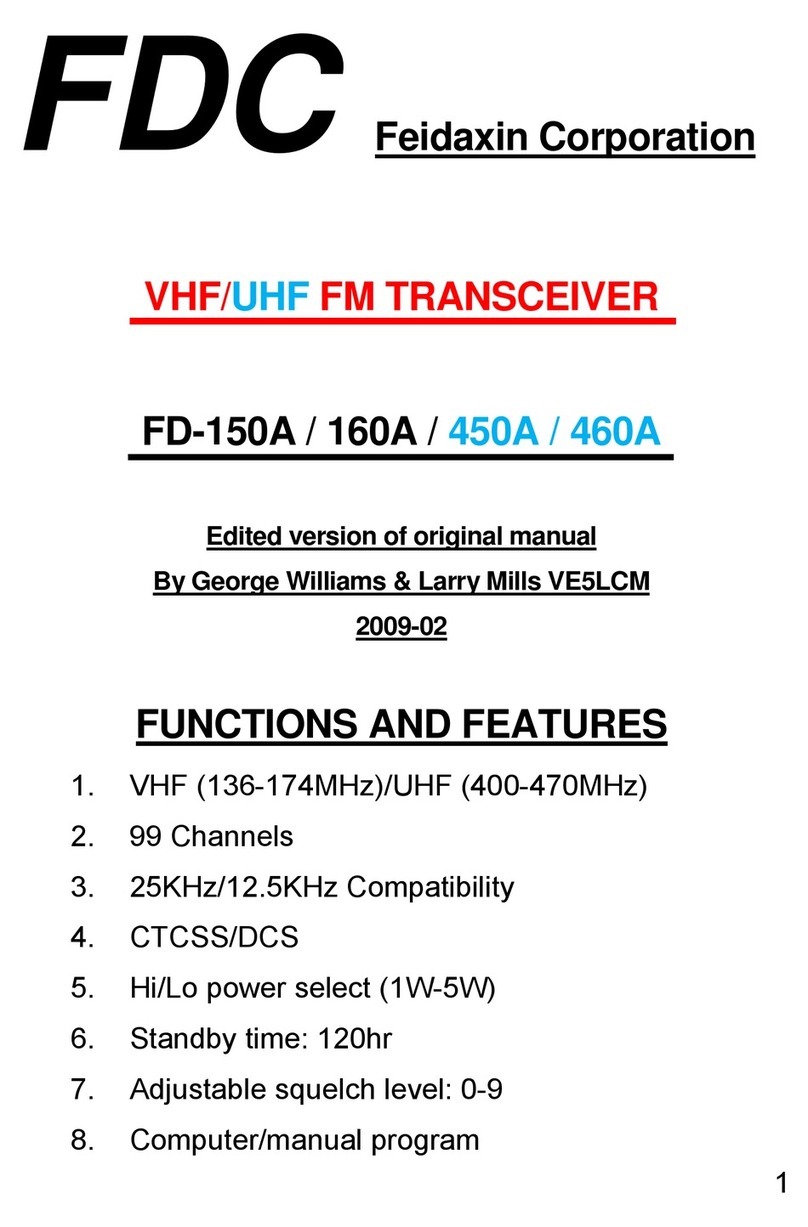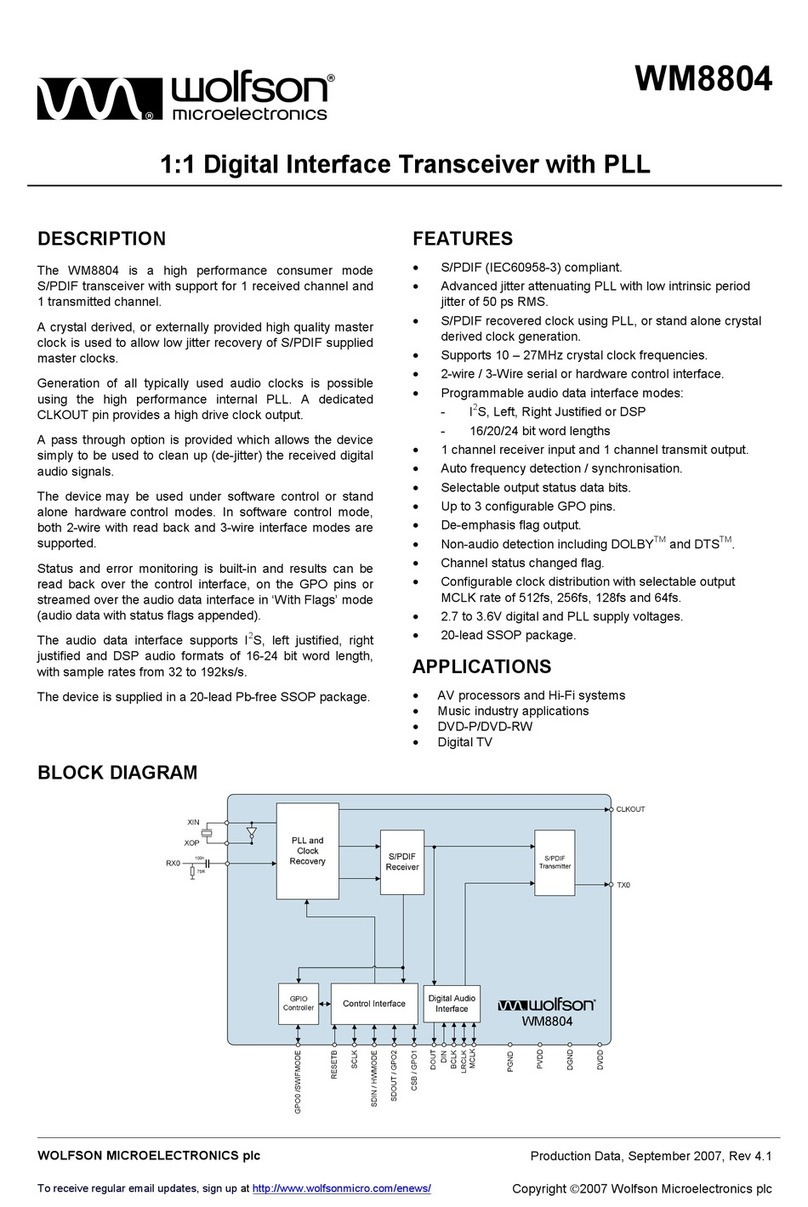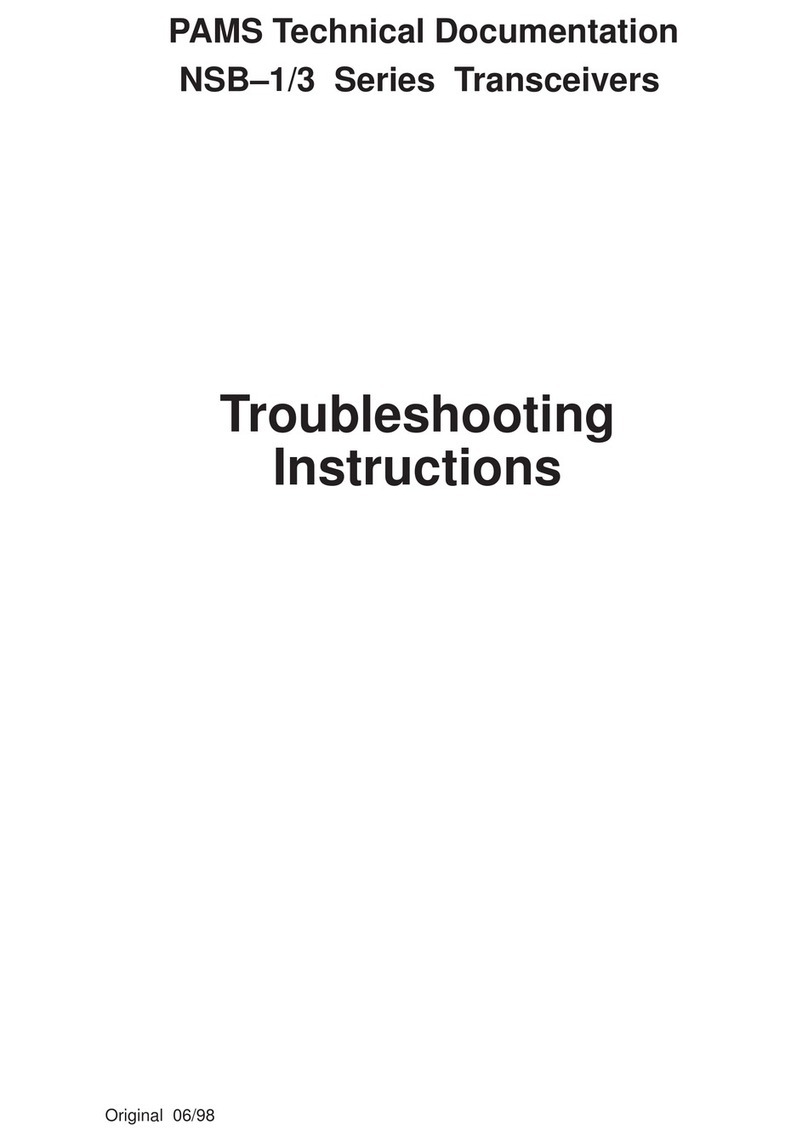Icom IC-04A User manual

430/440MHZ FM TRANSCEIVER
IC-04A/AT/E
SERVICE MANUAL
Downloaded by
RadioAmateur.EU
ICOM INCORPORATED
6-9-16, Kamihigashi, Hirano-ku, Osaka 547, Japan
Phono :06 793 5301
Fax :06 793 0013
Telex :0527722 ICOMTR J
ICOM
ICOM AMERICA Inc.
<Corporate Headquarters)
2380 116th Avenue N.E.,
Bellevue WA 98004, U.S.A.
Phor>e :206 454 8155
Fax :206 454 1509*
Telex ;152210 ICOM AMER BVUE
ICOM CANADA
ADivision of ICOM America Inc.
3071 #5 Road, Unit 9, Richmond, B.C.,
vex 2T4, Canada
Phone :804 273 7400
Fax :604 273 1900
ICOM (UK) ltd.
Unit 9, Sea Street, Herme Bay,
Kent CT6 8LD, United Kingdom
Phone :0227 363859
Fax :0227 360155
Telex :965179 ICOM G
<Regionai Customer Service Center)
31 50 Premier Drive, Suite 126. Irving,
TX 75063, U.S.A.
Phone :214 550 7525
Fax :214 594 7079
<Cu8tomer S^ic»)
F^one :206 454 7619
ICOM (EUROPE) GmbH
Himmelgelster Str. 100,
4000 Dusseldorf 1
,
Fed. Rep. Germany
Fon ;021 1346047
Fax :021 1333639
Telex :8588082 ICOM D
ICOM FRANCE S.a
120 Route de Revel,
31029 Toulouse Cedex, France
Telex 1521515 ICOM FRA
Phone :61. 20. 31, 49
Fax :61.34. 05. 91
ICOM (AUSTRALIA) Pty. ltd.
1777 Phoenix Parkway, Suite 201.
Atlanta, GA 30349, U.S.A.
Phone :404 991 6166
Fax :404 991 8327
7Duke Street, Windsor. Victoria,
3181 Australia
Phone :03 51 2284, 03 529 7582
Fax :03 529 8485
Telex :AA 35521 ICOM AS

INTRODUCTION
This service manual contains information relative to the
theoretical, physical, mechanical and electrical characteristics of
the IC-04A/AT/E 430/440MHz FM TRANSCEIVER.
ASSISTANCE
Four separate versions of the IC-04A /AT /E have been designed
for use in the Europe, U,S.A., Australia, and Southeast Asia.
This service manual covers every version. When using the
manual each model can be referred to by the following assigned
version numbers:
MODEL 1
1
VERSION NO. ;VERSION FREQUENCY
RANGE (MHz) TONE
ENCODERS TUNING
STEP IkHi}
IC-04E #04 jEurope (3) 430-000-439.9&7S
1
TONE
CALL 12.5
IC-04AT 1ItOb 1
J
U.S.A. H) 440.000"- 449. 99 5DTMF
CTCSS S
#07
ii
Australia i430.000-439. 995 111E
1C' 04AT i#09
[;
Southeast
Asia 12} 430.000—439.995 DTMF
CTCSS B
If you require assistance or further information regarding the
operation and capabilities of the IC-04A/AT/E please contact
your nearest authorized ICOM Deafer or ICOIVt Service Center.
1&3A
.. i: LUi-iK
B e B
7
sm-m B e c
33Ff;-J
a#o
ORDERING PARTS
For faster, more efficient service include the following points
when ordering parts or requesting information from your ICOM
Service Center:
1. Equipment mode! and serial number
2. Schematic part identifier {e.g,, Q205)
3. Printed circuit board name and number (e.g., PLLUNIT/B-8161)
4. Part number and name (e.g., 2SC2668-0 Transistor)
5. Quantity required {e.g., 3pcs)
I;i
JI
I
i
]
D1!W ,
REPAIR NOTE
1.DO NOT open transceiver covers until the transceiver is disconnected from a
power source.
2. DO NOT connect the transceiver to an external power source of more than 16V
DC.
3. DO NOT force any of the variable components. Turn them slowly and smoothly.
4. DO NOT short any circuits or electronic components.
5. An insulated tuning tool MUST BE used for all adjustments.
6. DO NOT keep power ON for along time when the transceiver is defective.
7. DO NOT transmit power into asignal generator or sweep generator. Always con-
nect a30dB or 40dB attenuator between the transceiver and adeviation meter or
spectrum analyzer when using such test equipment,
8. Read the instructions of test equipment thoroughly before connecting the equip-
ment to the transceiver.

TABLE OF CONTENTS
SECTION 1SPECIFICATIONS 1-1
SECTION 2OUTSIDE AND INSIDE VIEWS 2-1~2
2-1 OUTSIDE VIEWS 2-1
2-2 INSIDE VIEWS 2-2
SECTION 3BLOCK DIAGRAM 3-1
SECTION 4CIRCUIT DESCRIPTION 4-1~9
4-1 RECEIVER CIRCUIT 4-1
4-2 TRANSMITTER CIRCUIT 4-2
4-3 PLL CIRCUIT 4-3
4-4 POWER SUPPLY CIRCUIT 4-5
4-5 COMPARATOR, REDUCED VOLTAGE DETECTION CIRCUITS 4-5
4-6 LOGIC CIRCUIT 4-6
4-
7OTHER CIRCUITS 4-6
SECTION 5MECHANICAL PARTS AND DISASSEMBLY 5-1-4
5-
1REAR PANEL DISASSEMBLY 5-1
5-2 FRAME DISASSEMBLY 5-1
5-3 SOLDER SIDE DISASSEMBLY 5-2
5-4 TOP PANEL DISASSEMBLY 5-3
5-5 HEATSINK DISASSEMBLY 5-3
5-6 SPEAKEY/MICROPHONE DISASSEMBLY 5-4
5-7 BOTTOM UNIT DISASSEMBLY 5-4
5-8 PTT PLATE AND PTT SEAL DISASSEMBLY 5-4
5-
9LOGIC UNIT AND LCD DISASSEMBLY 5-4
SECTION 6MANTENANCE AND ADJUSTMENT 6-1-5
6-
1MEASURING INSTRUMENTS REQUIRED FOR ADJUSTMENTS 6-1
6-2 CHECK THE FUNDAMENTAL VOLTAGES 6-2
6-3 PLL ADJUSTMENT 6-3
6-4 RECEIVER ADJUSTMENT 6-3
6-5 TRANSMITTER ADJUSTMENT 6-4
6-
6SUBAUDIBLE TONE, DTMF AND TONE CALL ADJUSTMENT 6-5
SECTION 7BOARD LAYOUT 7-1—4
7-
1MAIN UNIT 7-1
7-2 PLL UNITAND VCO UNIT 7-2
7-3 LOGIC UNIT 7-3
7-4 TONE UNIT 7-4
7-
5TONE CALL UNIT 7-4
SECTION 8SCHEMATIC DIAGRAM 8-1-4
8-
1MAIN UNIT 8-1
8-2 PLL UNIT 8-2
8-3 LOGIC UNIT 8-3
8-4 TONE UNIT 8-4
8-
5TONE CALL UNIT 8-4
SECTION 9TROUBLESHOOTING 9-1-4
9-
1NOPOWER 9-1
9-2 PLL FAILURE 9-2
9-3 NO RECEPTION 9-3
9-4 NO TRANSMIT RF POWER 9-4
SECTION 10 PARTS LIST 10-1-8
SECTION 1 1 1C. TRANSISTOR AND PIN CONNECTIONS 11-1-3
The SCHEMATIC DIAGRAM is attached at the end of this manual

SECTIOIM 1SPECIFICATIONS
GENERAL
Frequency coverage
and tuning steps
Frequency readout
Frequency control
Frequency stability
Memory channels
Scanning
Usable temperature range
Antenna impedance
Power supply requirement
Current drain at 8.4V
Dimensions(with IC-BP3)
Weight
TRANSMITTER
Output power
Emission mode
Modulation system
Max. frequency deviation
Spurious emissions
Microphone
Operating mode
RECEIVER
Receiveing system
Intermediate frequencies
Sensitivity
Squeich sensitivity
Spurious response rejection ratio
Selectivity
Audio output power
Audio output impedance
MODEL VERSION NO. VERSION FREQUENCY RANGE (MHz) TUNING STEP (kHz)
IC-04E #04 Europe <31 430.000~439.9875 12.5
IC-04AT #05 U.S.A. (1) 440.000~449.995 5
IC-04A #07 Australia 430.000~439.995 5
IC-04AT #09 Southeast
Asia (2) 430.000~439.995 5
:6digit 5kHz LCD READOUT
:Digital PLL synthesizer with key input
:Within 0.001 %in range of -10°C~ +60°C
:10
:Programmed scan and memory channel scan available
:-10"C~ +60°C
;500 unbalanced
:DC 5.5~16.0V negative ground is acceptable
([DC INI JACK accepts 10~16V)
:Transmit HIGH (2.5W) Approx. 1.25A
LOW (0.5W) Approx. 550mA
Receive At max audio output Approx. 150mA
Squelched Approx. 45mA
:65(74)W X160(171)H X35(41)D mm
(Bracketed values include prelections)
:515g(IC-04AT/E) 495g(IC-04A)
:HIGH 2.5Wat8.4V (5W at 13.2V)
LOW 0.5W at 8.4V~1 3.2V
:F3
:Variable reactance frequency modulation
:±5kHz
;More than 60dB below carrier output power
:Built-in electret condenser microphone
Optional Speaker-microphone (IC-HM9) and Headset (HS-10) can be used.
:Simplex
Duplex (Any in-band frequency separation is programmable.)
:Double-conversion superheterodyne
:1st 21.8MHz, 2nd 455kHz
:Less than 0.3^V for 12dB SINAD
Less than 0.4;«V for 20dB noise quieting
Less than 0.1 //V
:More than 60dB
:More than ±7. 5kHz at —6dB point
Less than ±15kHz at —60dB point
:More than 500mW (at 80 with 10% distortion)
:80
1-1

SECTION 2OUTSIDE AND INSIDE VIEW
2-1OUTSIDE VIEWS
TOP VIEW
Utlf tHAISlSCilVER
lC^04Ar
4FK M:lUrm'ttrtiKi'
DC IN JACK EXTERNAL MIC JACK
EXTERMALSPEAKER JACK
ANTENNA CONECTOB
VOLUME CONTOL and
POWER SWITCH
LIGHT SWITCH
SQUELCH CONTROL
RF POWER SWITCH
FRONT VIEW
frequency display
REAR VIEW SIDE VIEW
FUNCTION KEY
TONE call SWITCH
(IC-04E onlyl
PTT SWITCH
BATTERY PACK
RELEASE BUTTON
MICROPHONE CHARGER JACK
BATTERY CHARQE INDICATOR
SPEAKER
BATTERY PACK
2-1

2-2 INSIDE VIEWS
S)l*«
b^kib
^njffisutp
wm««d
Jftb IfflfiJP ’
i^eQ2
HBDl
^A&06
PLL UNIT
MAIN UNIT
CircuLt
Protector Heatsink
BL101
IC202 RF Power Amp
(SG 1026)
AF Power Amp Circuit
iClOl (pPC353 C
Mic Signal Low-pass Filter}
ICl 05 {TA75393P
Low Battery Sensor) 21..aiVlHi Filter
IC103 Sousich Control
ITC4O09 }VCO Unit
BT101 (BRZ325 IHC
Lithiurr; Battery) Dual Modulous Prescalar
IIC204 PLL 1C
IIIPD2834 )
Voltage Regulator Circuit
X203 Reference DSC
II
C
203 Prescaler
7(VPB571)
LOGIC UNIT TONE UNIT {1C-04AT only)
IC501 DTMF Encoder
(LR40e?)
Initial Matrix
X502 CTCSS OSC
(3.G79545MHI)
IC401 MPU
(H044795600} IC503
CTCSS Encoder
(S-7110A)
XS01 DTWtF OSC
{3.58 MHz)
Speaker TONE CALL UNIT HC-04E only(
X601 {7.16SOMHZOSC)
iceoi Divider
{TC50S2 P}
2-2

3-1

SECTION 4CIRCUIT DESCRIPTION
4-1 RECEIVER CIRCUITS
4-1-1 ANTENNA SWITCHING CIRCUIT
(PLL UNIT)
Receive signals enter the PLL UNIT from ANTENNA
CONNECTOR J201 and pass through aChebyschev
low-pass filter consisting of L223, L224, and
C289~C291 .The antenna switching circuit employs
a4/2-type diode switching system which does not
allow current to flow while receiving.
4-1-2 RF CIRCUIT (PLL UNIT)
The receive signals from the antenna switching circuit
pass through abandpass filter consisting of C202,
C203 and L201, and are amplified at RF amplifiers
0201 and 0202. Bandpass filters are designed for the
after stage of each RF amplifier circuit to further sup-
press out-of-band signals.
After passing through the bandpass filter, signals are
fed to 1St mixer 0203 for conversion to 21.8MHz 1st IF
signals with LO signals from the PLL circuit.
4-1-3 IF CIRCUIT (PLL UNIT)
1st IF signals from 0203 pass through apair of crystal
filters (FI201) to suppress out-of-band signals and un-
wanted heterodyned frequency signals. After passing
through the filter, the 1st IF signals are amplified at IF
amplifier 0204, pass through matching coil L208, and
are fed to IC201
.
IC201 contains the 2nd LO circuit, 2nd mixer circuit,
limiter amplifier circuit and quadrature detector circuit.
The 2nd LO circuit and X201 generate 21 .345MHz 2nd
LO signals which are used at the 2nd mixer section of
IC201.
1St IF signals from L208 are fed to pin 16 of IC201 ,and
are mixed with 2nd LO signals for converting the 1st IF
signals to 455kHz 2nd IF signals.
L22t
The 2nd IF signals are output from pin 3and pass
through high-quality ceramic filter FI202 to suppress un-
wanted heterodyned frequency signals. They are then
amplified at the limiter amplifier section (pin 5of IC201
)
and applied to aquadrature detector circuit (the
quadrature detection section of IC201) and ceramic
resonator X202 to demodulate 2nd IF signals to AF
signals.
S-Meter Amp S-M#ter Amp 455kHz 21.345MHz 1st IF Amp
Q20S Q20S FI202 X207 02M
4-1

4-1-4 S-METER CIRCUIT (PLL UNIT)
Aportion of signals passed from FI202 is amplified at S-
meter amplifier Q205 and Q206, and is detected at
voltage doubler rectifiers D201 and D202. These
signals are then applied to meter comparator IC105A
on the MAIN UNIT.
4-1-5 AF CIRCUIT (MAIN UNIT)
AF signals output from pin 9on IC201 are applied to the
MAIN UNIT, and pass through ade-emphasis circuit
consisting of R127 and Cl 17. These signals are then
amplified at AF controller Q105. This de-emphasis cir-
cuit is an integrator circuit with frequency
characteristics of 6dB/oct.
The AF amplifier circuit consists of Q1 16~Q122. The
input section (Q1 16and Q1 17) functions as adifferen-
tial amplifier to ensure stable operations and asuitable
frequency response by the negative feedback network
of R152 and R149. The AF power amplifier circuit is a
complementary SEPP circuit with aDarlington connec-
tion of Q1 19~Q1 22. This circuit drives the speaker.
When the power source voltage is more than 10V,
D106 and voltage regulator Q106 limit output voltage
and output power, stabilizing the bias.
Astandby current suppressor (Q1 32) is installed to sup-
press the current and residual noise while the squelch is
closed.
4-1-6 SQUELCH CIRCUIT (MAIN UNIT)
Noise components from pin 9of IC201 are fed to active
filter IC101B through SQUELCH CONTROL R126.
This active filter is ahigh-pass filter, and amplifies ap-
proximately 20kHz noise components. The noise com-
ponents are then rectified by D103 and converted to
DC voltage at R1 19, R1 20, Cl 11,and Cl 12. The DC
voltage passes through inverters IC103B and IC103A
to obtain aTTL level from alinear level.
AF controller 0105 is turned OFF by the "HIGH"
voltage level from pin 2of IC103A. Output signals from
pin 2of IC103A are also fed to MPU IC401 in the
LOGIC UNIT through D104 as asquelch signal.
When no RF signal is received, noise rectified output
voltages from D103 are "HIGH". Pin 2of IC103A thus
becomes "HIGH" and 0105 turns OFF. AF output is
then cut OFF.
In transmit mode, T-l- 5signals are applied to pin 9of
IC103B via D105 to turn 0105 OFF.
4-1-7 1St LO CIRCUIT (VCO AND PLL UNITS)
450MHz band LO signals from the VCO UNIT are buffer
amplified at 0208 and fed to transmit/receive swit-
ching circuit D208 in the PLL UNIT. The signals are then
applied to the base of 1st mixer Q203 as 1st LO signals.
4-2 TRANSMITTER CIRCUITS
4-2-1 MICROPHONE AMPLIFIER CIRCUIT
(MAIN UNIT)
AF signals from the INTERNAL MICROPHONE or from
EXTERNAL MIC JACK J202 are amplified at alimiter
amplifier consisting of Q101~Q104.
This limiter amplifier is formed by anegative feedback
circuit with frequency characteristics set at 6dB/oct.
from 300Hz to 3kHz. This causes the limiter amplifier
to function as apre-emphasis circuit. Output from the
limiter amplifier is similar to arectangular waveform
and includes harmonic components.
Harmonic components higher than 3kHz are attenuated
by splatter filter IC101A.
AF signals from IC101A pass through modulation ad-
justing trimmer pot R226 in the PLL UNIT and are then
applied to the anode of D703 in the VCO UNIT for per-
forming frequency modulation.
4-2-2 BUFFER AMPLIFIER CIRCUIT (PLL UNIT)
430 or 440MHz band signals output from the VCO
UNIT are buffer amplified by 0208 and pass through
transmit/receive switching circuit D209. They are then
amplified at predriver 021 1,and driver 021 2, thus ob-
taining awideband of 150mW.
4-2

r+5
4-2-3 POWER AMPLIFIER CIRCUIT
Amplified signals at Q212 are power-amplified at
IC202.
IC202 is asmall-sized power module giving stable out-
put power of more than 5W with adriving power of
150mW. The output power from IC202 is passed
through the APC detector circuit, the antenna swit-
ching circuit, alow-pass filter, and then applied to the
ANTENNA CONNECTOR.
While transmitting the antenna switching circuit con-
sisting of Q218, D213 and D214 is turned ON and
L221 and C284 become parallel resonance circuits to
prevent signals being applied to the receiver circuits.
Q210 controls the bias voltage of Q211, 0212 and
IC202 to prevent unwanted emissions when switching
from receive to transmit mode, or when the PLL circuits
are unlocked.
4-2-4 APC AND POWER SET CIRCUITS
(PLL UNIT)
The APC detector circuit consists of L219, D21 1and
D212. When antenna impedance is matched at 50Q,
voltage detected at D211 and D212 has aminimum
value. However, when antenna impedance is in a
mismatched condition, the detected voltage becomes
higher than it is in the matched condition.
0216 and 0217 form the differential amplifier circuit.
The base bias of 021 7(reference voltage) is determin-
ed by R263, R264 and R265.
The voltage detected at 021 1and D21 2is combined by
R245 and R246, and fed to the base of 0216.
When the antenna is mismatched with the transceiver
the base voltage of 0216 is higher than the base
voltage of 021 7. The 0216 collector current and 021
5
base current are then reduced, decreasing the 0214 col-
lector current. This decreases the output power of
0211 and 0212 until the base voltage of 0216
becomes the same as the base voltage of 0217.
L219
In amatched condition, RF POWER SWITCH SI 05 is in
the "HIGH" position and RF output power can be ad-
justed by R264. In the "LOW" position aseries combina-
tion of R267 and R266 is connected in parallel with
R265. RF output power can then be adjusted by R267.
The output voltage detected at D21 1and D21 2passes
through R272 and is applied to meter comparator
IC105A on the MAIN UNIT.
4-3 PLL CIRCUITS
The PLL circuits adopt adual modulus prescaler
system.The circuits generate the desired frequency
directly in the VCO circuit.
The PLL circuits are composed of prescaler IC203 and
PLL 1C IC204.
Ndata is the number of times desired frequency is divid-
ed by the reference frequency. The desired frequency is
transmit frequency in transmit mode and the 1st LO fre-
quency in receive mode.
Desired frequency
N-data =Reference frequency
Downloaded by
RadioAmateur.EU
4-3

4-3-1 REFERENCE FREQUENCY CIRCUIT
(PLL UNIT)
IC204 incorporates aswallow counter of 6binary bits,
aprogrammable counter of 11binary bits, aphase com-
parator, acharge pump and afrequency divider for the
reference frequency.
A5.12MHz (#04 6.4MHz) signal is oscillated at
reference oscillator Q213 and X203, and is fed to pin
17 of IC204. IC204 divides the frequency by 1/1024
and areference frequency of 5kHz (#04 6.25kHz) is ob-
tained. The reference frequency is fed to pin 8of
IC203.
4-3-2 DUAL MODULUS PRESCALER
Signals from the VCO UNIT are buffer amplified at
Q220 and divided Ntimes at IC203 and IC204. Signals
are then phase detected at IC204 and the detected
signals are output from pin 1 1
.
IC202 is aprescaler that divides signals generated by
the VCO UNIT by either 1/64 or 1/65.
4-3-3 LOOP FILTER, VCO, MODULATION
CIRCUITS (PLL AND VCO UNITS)
Output from pin 11of IC204 determines the character-
istics of the PLL circuits through alag lead type loop
filter consisting of R248, R249 and C294. This out-
put controls D701 in the VCO UNIT.
The VCO (0702) employs aColpitts oscillator circuit.
The VCO free run frequency is shifted by inductive
capacitance with 0701 and D702.
In receive mode, 0701 turns OFF then the free run fre-
quency is determined by L703, C703 and C702. In
transmit mode, 0701 turns ON then D702 is activated.
Thus C706 and C705 are parallel connected with C702
and C703. As aresult the free run frequency is shifted
lower than receive frequency.
Stable oscillation is controlled by varactor diode D701
and is achieved over awide frequency range.
While the transceiver is transmitting, modulation
signals are applied to the anode of D702,d^anging its
capacitance performing frequency modulation.
4-3-4 UNLOCK CIRCUIT (PLL UNIT)
When the PLL cirucit is unlocked, pin 10 of IC204 is
"LOW" and a"LOW" signal is fed to pin 8of IC102A as
unlock signals through atime constant circuit con-
sisting of R251 and C296.
In transmit mode pin 9of IC102A is "LOW" thus unlock
signals are applied to the MPU from pin 10 of IC102A.
MPU PLL IC
w
/C407 JC20U
10
PRESCALER PLL IC
IC203 K20i

4-4 POWER SUPPLY CIRCUIT
4-4-1 INTERNAL/EXTERNAL POWER SWITCHING
CIRCUIT (MAIN UNIT)
When using an attached battery pack, relay RL101 is
OFF and POWER SWITCH R1 32 is connected to the bat-
tery pack. When apower source with voltage between
10-16V is connected to EXTERNAL DC POWER JACK
J203, RLl 01 is ON and R1 32 is connected to the exter-
nal power source.
In case awrong connection to J203 is made with
reverse polarity. Dll
7
is reversely biased, preventing
RLl 01 from being ON and protecting the transceiver.
4-4-2 VOLTAGE REGULATOR CIRCUITS
(MAIN UNIT)
Athree terminal voltage regulator (IC104) keeps the
output voltage at 5V constantly even when input
voltage is from 5.1V to 16V.
Noise components are eliminated from the output of
IC104 through afilter circuit consisting of R165 and
C138. Output from the filter circuit is fed to acurrent
amplifier circuit consisting of 0129 and 0130.
01 29 and Q1 30 are connected in acomplementary cir-
cuit for ahigher current amplification factor. The base
voltage of 01 30 is nearly equal to the output voltage of
1C 104. Also, the collector voltage of 0129 is approx-
imately 5V. As the temperature coefficient of the junc-
tion voltage of D1 14 is nearly equal to the Vbe of 01 30,
the output voltage is kept constant against any change
in temperature.
The regulated 5V from the collector of 0129 is fed to
common circuits through current amplifier circuit 0114
and 0115, and is also fed to transmit/receive switching
circuit 0108 and 0109.
In receive mode, pin 3of IC103 is "LOW" and 0108 is
turned ON to feed R-i- 5through current amplifier 0110
and 01 11.At this time, 0109 is turned OFF.
In transmit mode, pin 3of 1C 103 is "HIGH" and pin 4of
IC103 is "LOW". 0108 is turned OFF and 0109 ON.
Thus 01 09 feeds T+5through current amplifiers 0112
and 0113.
4-4-3 MPU POWER SOURCE CIRCUIT
(MAIN UNIT)
When the battery pack is removed from the transceiver,
avoltage is applied to MPU IC401 in the LOGIC UNIT
via D1 19 from LITHIUM BACKUP BATTERY BT101 to
provide backup for the memory contents.
4-4-4 VOX POWER SOURCE CIRCUITS
(PLL UNIT)
The current limiter circuit consists of 0219, D217,
R273, R274 and R275. This circuit has acurrent limit of
maximum 5mA and supplies avoltage to the optional
HS10SA VOX UNIT.
When the current is overloaded 0219 reduces the cur-
rent until the base voltage of 0219 plus Vbe and the
emitter voltage of 0219 are the same.
R+5rs5 +5 r+5
4-5 COMPARATOR, REDUCED VOLTAGE
DETECTION CIRCUITS
4-5-1 COMPARATOR CIRCUIT (MAIN UNIT)
The voltage detected in the Smeter circuit or APC cir-
cuit is input to pin 3of IC105A. D/A signals from the
MPU are fed to pin 2of IC105A.
The MPU counts up and outputs 4bit digital signals un-
til pin 2of IC105A becomes higher than pin 3. These
signals are converted to an analog signal with R409
R412 in the LOGIC UNIT. The signals are divided at
R166 and R179 in the MAIN UNIT and changed to 16
step D/A signals between 0.12V and 1.258V.
When the voltage at pin 2of 1C 105Ais higher than pin
3, the output at pin 1is "LOW" and applied to the MPU
as the COMP signal. The MPU indicates the counting
number to the S/RF INDICATOR as the signal strength
in receive mode and as RF output power in transmit
mode.
4-5

4-5-2 REDUCED VOLTAGE DETECTING
CIRCUIT (MAIN UNIT)
The reduced voltage detecting circuit consists of
IC105B, R168, R169, and R171.
Aregulated 5V is divided at R168 and R169 and a
voltage of approximately 1.03V is applied to pin 6of
IC105B. The voltage of the Vcc is divided by R1 70 and
R1 71 ,and is applied to pin 5. The voltage division ratio
is selected so that the voltage at pin 5is 1,03V when
the Vcc is approximately 5.6V.
If the Vcc is greater than 5.6V, the voltage at pin 5of
IC105B is higher than that at pin 6. Pin 7then becomes
"HIGH". If the Vcc voltage decreases to less than 5.6V,
the voltage at pin 5is less than that at pin 6 and the out-
put voltage at pin 7and the output of IC105B is "LOW".
This information is fed to MPU IC401 ,causing the BAT-
TERY CONDITION INDICATOR to appear on the FRE-
QUENCY DISPLAY.
4-6 LOGIC CIRCUITS
The main part of the logic circuits is MPU IC401 .This in-
cludes a2k word ROM, 128 word ROM, 160 byte
RAM, and acircuit to drive FREQUENCY DISPLAY
DS401.
The next 4-7 page allocation is an explanation of opera-
tions and their I/O ports.
4-7 OTHER CIRCUITS
4-7-1 LAMP CIRCUIT (MAIN UNIT)
The lamp circuit consists ofQ131, Dll 5, Dll 6, and
other components and drives backlight DS401 at acon-
stant current, ensuring that brightness does not change
even with achange of power supply voltage.
When S106 is turned ON current flows into R173,
resulting in the base voltage of Q131 being approx-
imately Vcc 1.2V as determined by D115 and Dll 6.
The emitter voltage of Q131 is then Vcc 0.6V and the
voltage at both ends of R172 is kept constant. The
result is aconstant current even with achange of
power supply voltage.
4-7-2 BEEP CIRCUIT (MAIN UNIT)
This is aphase shift oscillator consisting of IC103F,
R155-R158, Cl 31, Cl 32, and Cl 34. The circuit
oscillates when the cathode of D1 13 becomes "HIGH".
The oscillating frequency is set at approximately
2500Hz.
4-7-3 TRANSMIT/RECEIVE SWITCHING CIRCUIT
(MAIN UNIT)
When PTT SWITCH S101 is pushed, Q107 turns ON
and pin 13 of IC103C and pin 1of IC102 become
"HIGH". Pin 2of IC102C remains "LOW" for approx-
imately 20msec. via time constant circuits R138 and
C122. After 20msec. pin 2of IC102C becomes
"HIGH", and then pin 3of IC102C becomes "HIGH".
Thus Q108 is turned OFF and Q109 is turned ON, then
the T+5and TS5 lines become 5V. "Transmit mode"
information is sent to the MPU from pin 12 of IC103C
via D107 with no delay time.
MUTE signals from IC401 are "HIGH" and applied to pin
13 of IC102D from MPU IC401 for approximately
60msec. to mute RF output signals, preventing
unstable signals from using Q210 in the PLL UNIT.
When SI 01 is released after 20msec, pin 3of IC102C
is "LOW" and turns Q108 ON and and Q109 OFF.
4-7-4 DTMF ENCODER CIRCUIT (TONE UNIT)
iifOS version only)
IC501, the DTMF encoder, generates Dual Tone Multi-
Frequencies. While transmitting, Q505 turns ON, ap-
plying voltage to IC501 .If any keys on the KEYBOARD
are pushed at this time, the proper frequency dividing
ratio for the dividing frequency of X501 (3.58MHz) is
selected to output one set of audio frequencies cor-
responding to row input and column input from pin 1
6
of IC501.
Also, a"HIGH" level is applied from pin 10 of IC501
when the KEYBOARD is activated. This level has atime
constant of approximately 1msec for turning Q506 ON.
Thus key entries can be made without holding the PTT
SWITCH down.
4-7-5 SUBAUDIBLE TONE ENCODER CIRCUIT
(TONE UNIT) {#05 and #09 versions)
When atone number is set, data is sent to IC502 from
MPU IC401 on the LOGIC UNIT. IC502 converts serial
data from IC401 to parallel data, and feeds it to IC503.
IC503 divides the frequency of X502 (3. 579545MHz)
corresponding to data, and outputs asubaudible tone
from pin 1
.
4-7-6 TONE CALL CIRCUIT (TONE UNIT)
(#04 version only)
The TONE CALL UNIT generates a1750Hz subaudible
tone to open arepeater. When the TONE BURST
SWITCH is pushed, Q601 turns ON and Vcc is applied
to IC601. IC601 divides 7.1680MHz by 1/4096 and
outputs 1750Hz from pin 4.
6

MPU PORT ALLOCATIONS
PORT NUMBER
DO [SEND]
D1 [MUTE]
D2 [CKJ
D3 [DATA]
D4[COMP]
D5 [UNLOCK]
D6 [PLL]
D7 [CTCSS]
D8 [SQL]
D9[HALT CONT]
DIO [BEEP]
Dll [FUNC]
D12~D15[KEYSCAN]
RO [KEY RETURN]
R1 [INITIAL KEY
RETURN]
R2 [INITIAL KEY SCAN]
R3 [D/A]
INTO [INT 0]
INTI [BAT]
RESET [RESET]
PIN NUMBER DESCRIPTION
78 When this port is "LOW", the transceiver is in transmit mode
and inhibits keyboard entry.
79 This port remains "HIGH" for approximately 60msec. when the
transceiver is changed from receive to transmit mode.
80 This port outputs serial CK signals for the PLL and subaudible
tone encoder circuits.
This port outputs serial DATA signals for the PLL and subaudi-
ble tone encoder circuits.
When this port is "LOW" the number of R3 ports is indicated on
the S/RF INDICATOR.
When this port is "LOW" the D1 port is made "LOW" and "U'‘
appears on the FREQUENCY DISPLAY.
This port outputs astrobe signal for PLL N-data.
This port outputs astrobe signal for the subaudible tone en-
coder.
When this port is "LOW", scan functions are stopped and 2
dots light up on the S/RF INDICATOR.
This port remains "LOW" for afew milliseconds when it turns
power ON. It selects the address in the MPU and makes the
HLT port "HIGH".
This port remains "HIGH" for 40msec. when the KEYBOARD is
pushed to control the beep oscillator.
When this port is "LOW" the secondary key function is
selected.
10-13 These are output ports for keyboard scan and are connected to
the columns of the KEYBOARD.
14-17 These are input ports for the keyboard scan from ports
D12—D15 and are connected to rows on the KEYBOARD.
66-69 These are input ports for the initial matrix key scan from ports
R2 and determine frequency ranges, tuning step increments,
etc.
70-73 These are output ports for the initial matrix key scan.
74-77 These ports output aloop counter number in hexadecimal and
count up until the COMP port receives a"LOW" signal to com-
pare and read S/RF voltage.
64 When the transceiver is turned OFF this port is "LOW" and the
HALT CONT port remains "HIGH" for afew milliseconds.
65 When this port is "LOW", the BATTERY CONDITION IN-
DICATOR lights up.
18 When this port is "HIGH", the MPU is initialized.
-7

SECTION 5MECHANICAL PARTS AND DISASSEMBLY
PREPARATION
1.Turn the power switch OFF.
2. Remove the BATTERY PACK
5-1 REAR PANEL DISASSEMBLY
1. Remove the 4flathead screws }M2.6x 6Nl) and
the battery pack sliding guide, battery pack lat-
ching plate, and battery pack release button from
the bottom of the transceiver.
2. Remove panhead screw (M2 x4ZK) and 4
panhead tapping screws (M2 x15 ZK) on the rear
panel.
41751
5-2 FRAME DISASSEMBLY
1.Slide the inner frame upward, and free the terminal
holder from the front pannel.
TOP PANELGASCKET
TERMINAL HOLDER
2. Lift the frame away from the front pannel and be
sure not to damage the flexible P.C. Board when
removing the front pannel.
3.
Remove the rear panel as shown in the figure.
FLEXIBLE P. C. BOARD B-812

3. Remove the 2panhead screws (M2 x4ZK).
PANHEAD TAPPING SCREWS BO 2x4^
4. Remove the tone or tone call P.C. Board as shown
in the figure.
5-3 SOLDER SIDE DISASSEMBLY
(MAIN, PLL UNITS)
1. Remove the two knobs (SQUELCH CONTROL,
VOLUME CONTROL and POWER SWITCH)
KNOBS AND COVER
N-76
2. Remove the 4flathead screws (M2x4) on each
side of the chassis.
5-2

3. Open the transceiver slowly on the MAIN UNIT and
PLL UNIT solder sides. Be sure not to damage the
MAIN UNIT P.C. Board.
Open slowly.
DO NOT brak tab.
CHASSIS (A) 30457 CHASSIS (B) 30357
5-4 TOP PANEL DISASSEMBLY
1.Remove the panhead screw (M2 x4 ZK).
2. Unscrew and remove the BNC nut and BNC washer
as shown in the figure.
Remove the ANTENNA CONECTOR by unsolder-
ing point (A) on the components side and point ®
on the solder side of the PLL UNIT.
BNC CONECTOR
BNC-RM-106
(Washer and nut included)
3. Remove the top panel by slightly prying it outward
on both sides.
5-5 HEATSINK DISASSEMBLY
1.Remove the two panhead screws (M2. 6x4Nl).
IIncnIHor at (7^nn tha shiplrl rasa.
5-3

5-6 SPEAKER/MICROPHONE DISASSEMBLY 5-8 PIT PLATE AND PTT SEAL DISASSEMBLY
PANHEAD TAPPING SCREW BO 2x5
SPEAKER HOLDING
PLATE 43021
SPEAKER 40P-177B_
SPEAKER SEAL
42542
MICROPHONE
KUC2023-01-0(
MIC HOLDER —
42541
MIC LUG 42931 htp=Q=i)>d
MIC CUSHION m
SPEAKER COVER )/K
SPEAKER COVER
42764
PTT PLATE
42546
PTT SEAL (A)
I42537 .
FLAT FILLISTER HEAD
SCREWS M2 X5B
5-9 LOGIC UNIT AND LCD DISASSEMBLY
FRONT SEAL42544-
5-7 BOTTOM UNIT DISASSEMBLY
rSCREW LUGS
TERMINAL P.C. BOARD 42556
II \^rl—rc—l-i
3fl
or-n o
E-RING M2
0-RING (E) 42249
CONTACT HOLDER 42534
PANHEAD SCREWS
2.6 X6(N)
KEYBOARD 42536
10-KEY SEAL 42543-
C=) 1=1 C=3
[1=1
!*
PANHEAD TAPPING
SCREWS BO 1.4x4
FRONT SHIELD
PLATE 42737
REFLECTION
PLATE 42616
LCD
LP-156AE
LCD SHIELD
42545
i\iK
PANHEAD TAPPING
SCREWS BO 1.4x4
RUBBER
CONDUCTOR
SRCN-297B i
ICOM WASHER (J)
^41910
SPRING 40998
CONTACT 42536 297 SHIELD SHEET 42767
5-4

INSTRUMENT GRADE AND RANGE
(1) Voltage regulated power supply Output voltage
Capacity
5~15V DC (Adjustable)
3A or more
(2) RF power meter {Terminated type) Measuringrange
Frequency range
Impedance
SWR
low
430 ~450MHz
50Q
Less than 1:1.2
(3) RF voltmeter Frequency range
Measuring range
0.1 -450MHz
0.001 -10V
(4) AC milli-voltmeter Measuring range lOmV -10V
(5) Voltmeter Input impedance 50kQ DC or better
16) Ammeter Measuring range 0-2A
(7) Distortion meter Frequency range
Measuring range
1kHz ±10Hz
1%~100%
(8) SINAD meter
(9) Audio generator Output frequency
Output voltage
Distortion
200-3000HZ
0—lOOmV
Less than 0.1%
(10) Attenuator Attenuator input
Power attenuation
At least 5W
30dB
(11) Signal generator Frequency range
Output level
0.1MHz -450MHz
0.1 j«V -3.2mV
(12) Frequency counter Frequency range
Accuracy
Sensitivity
0.1 -450MHz
Better than ±1ppm
lOOmV or better
(13) External speaker Impedance 8Q
(14) FM deviation meter Frequency range
Measuring range 430 -450MHz
0- ±10kHz
6-t

Downloaded by
RadioAmateur.EU
6-2 CHECK THE FUNDAMENTAL VOLTAGES
TEST INSTRUMENTS REQUIRED
£1 1VOLTAGE REGULATED POWER SUPPLY
£2i RF POWER METER
[5> VOLTMETER
CHECK CONDITION LOCATION VALVE
OCPOWOR 1Turn the POWER SWITCH ON. Connect the minus clip of voltineter tc
SUPPLY GND
{At Other end to fA| i3.av
IB] '5V
lEt 5V
(B) 2Push the PTT SWITCH. to 5V
[D| 5V
RECONDITION Addition check Failure point See figure
B6J0I
Check point
'iicios
tsomv
1.
J.6V
6-2
Other manuals for IC-04A
4
This manual suits for next models
2
Table of contents
Other Icom Transceiver manuals
Popular Transceiver manuals by other brands

Alan
Alan HP450 2A Rugged user manual
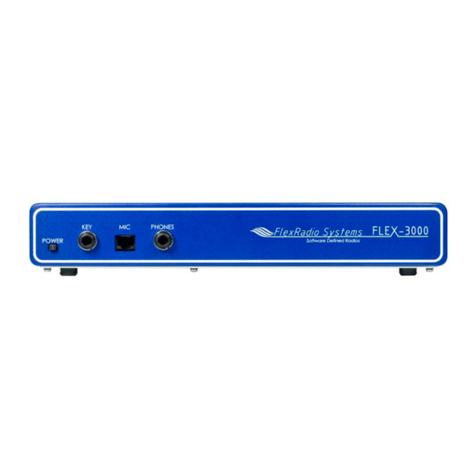
FlexRadio Systems
FlexRadio Systems Flex-3000 owner's manual
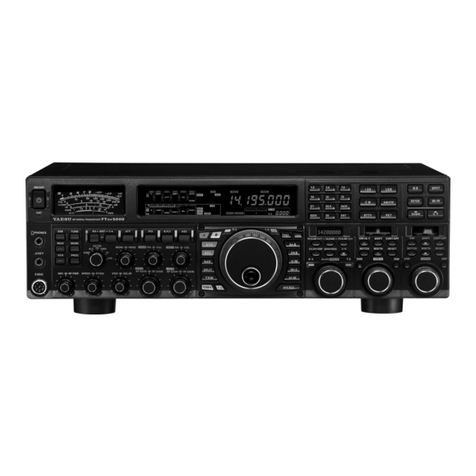
Yaesu
Yaesu FTDX5000 CAT BOOK operating manual

Teledyne Detcon
Teledyne Detcon RXT-320 instruction manual

Trio
Trio TS-530SP instruction manual
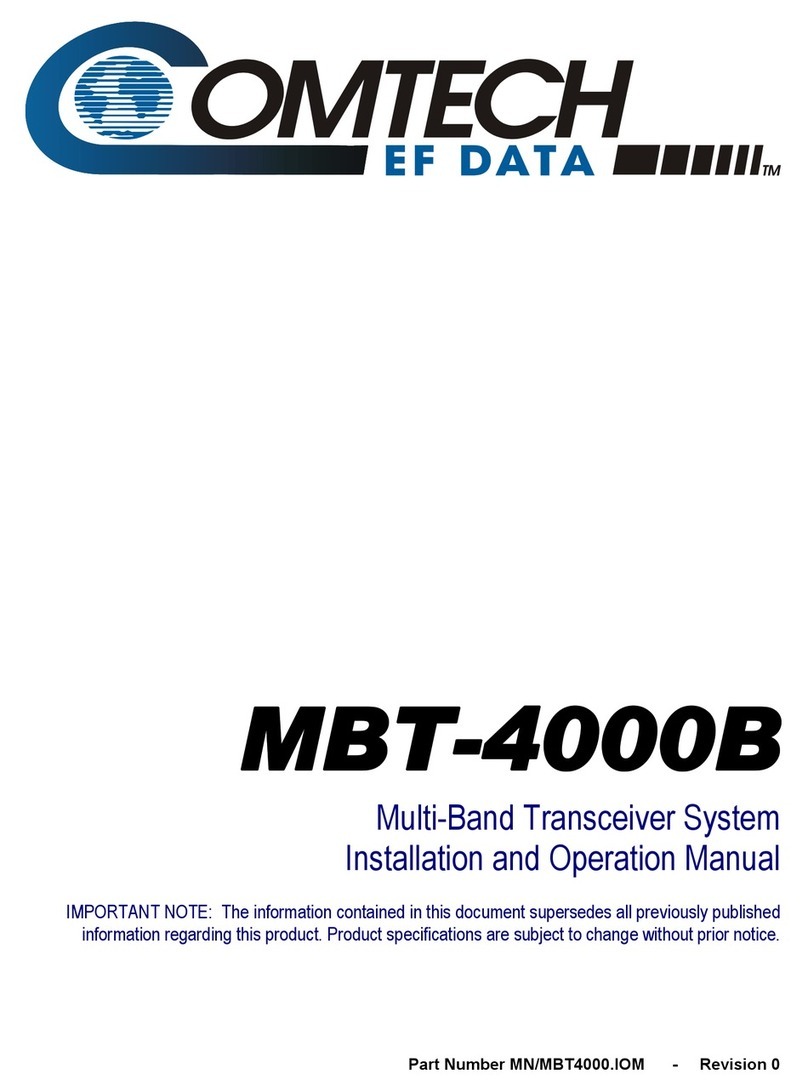
Comtech EF Data
Comtech EF Data MBT-4000B Installation and operation manual
